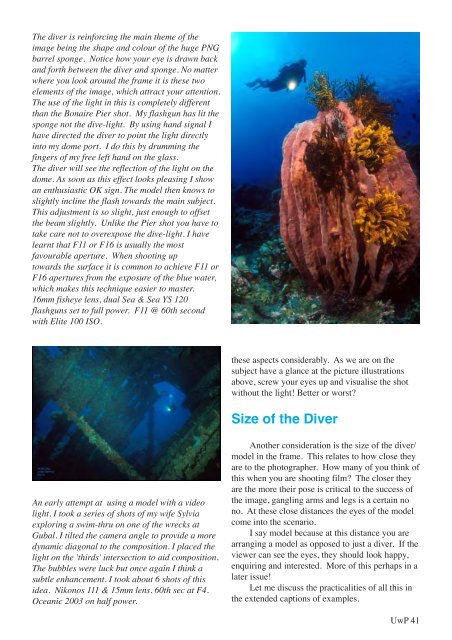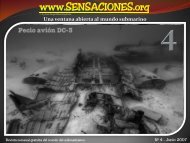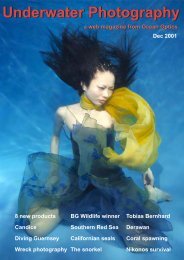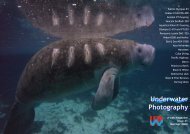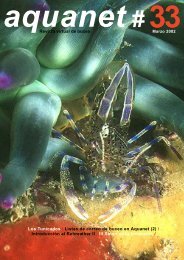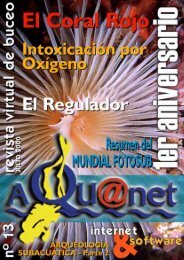Underwater Photography Underwater Photography
Underwater Photography Underwater Photography
Underwater Photography Underwater Photography
Create successful ePaper yourself
Turn your PDF publications into a flip-book with our unique Google optimized e-Paper software.
The diver is reinforcing the main theme of the<br />
image being the shape and colour of the huge PNG<br />
barrel sponge. Notice how your eye is drawn back<br />
and forth between the diver and sponge. No matter<br />
where you look around the frame it is these two<br />
elements of the image, which attract your attention.<br />
The use of the light in this is completely different<br />
than the Bonaire Pier shot. My flashgun has lit the<br />
sponge not the dive-light. By using hand signal I<br />
have directed the diver to point the light directly<br />
into my dome port. I do this by drumming the<br />
fingers of my free left hand on the glass.<br />
The diver will see the reflection of the light on the<br />
dome. As soon as this effect looks pleasing I show<br />
an enthusiastic OK sign. The model then knows to<br />
slightly incline the flash towards the main subject.<br />
This adjustment is so slight, just enough to offset<br />
the beam slightly. Unlike the Pier shot you have to<br />
take care not to overexpose the dive-light. I have<br />
learnt that F11 or F16 is usually the most<br />
favourable aperture. When shooting up<br />
towards the surface it is common to achieve F11 or<br />
F16 apertures from the exposure of the blue water,<br />
which makes this technique easier to master.<br />
16mm fisheye lens, dual Sea & Sea YS 120<br />
flashguns set to full power. F11 @ 60th second<br />
with Elite 100 ISO.<br />
these aspects considerably. As we are on the<br />
subject have a glance at the picture illustrations<br />
above, screw your eyes up and visualise the shot<br />
without the light! Better or worst?<br />
Size of the Diver<br />
An early attempt at using a model with a video<br />
light. I took a series of shots of my wife Sylvia<br />
exploring a swim-thru on one of the wrecks at<br />
Gubal. I tilted the camera angle to provide a more<br />
dynamic diagonal to the composition. I placed the<br />
light on the 'thirds' intersection to aid composition.<br />
The bubbles were luck but once again I think a<br />
subtle enhancement. I took about 6 shots of this<br />
idea. Nikonos 111 & 15mm lens. 60th sec at F4.<br />
Oceanic 2003 on half power.<br />
Another consideration is the size of the diver/<br />
model in the frame. This relates to how close they<br />
are to the photographer. How many of you think of<br />
this when you are shooting film? The closer they<br />
are the more their pose is critical to the success of<br />
the image, gangling arms and legs is a certain no<br />
no. At these close distances the eyes of the model<br />
come into the scenario.<br />
I say model because at this distance you are<br />
arranging a model as opposed to just a diver. If the<br />
viewer can see the eyes, they should look happy,<br />
enquiring and interested. More of this perhaps in a<br />
later issue!<br />
Let me discuss the practicalities of all this in<br />
the extended captions of examples.<br />
UwP 41


